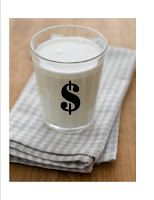IS OUR CHEESE WORTH THE WEIGHT?
Imagine that your breakfast of champions is a little different today. Instead of hitting your crunchy-o’s with an ice cold splash of milk you decide to go with black gold; oil that is. Maybe grab a petrol latte, double-tall, on your way to the office. Granted, you need a lot less milk to power your life – but that isn’t the case if you’re a cheese-maker. See where I’m headed now? We’ve had a few comment cards lately reflecting the public’s unrest with the climbing price of cheese. Some have even speculated that we are hiking our margins to reflect the premium ambiance in our fancy new store or to *gasp* finance our underground lair. We promise, folks, that our margins are the same and that as an importer and retailer we are feeling the heat right along with you (I catch my share of flack as the mistress of the money-pit downstairs). So, I did a little digging and found that there are a few more factors at play than the most obvious culprits, which are transportation costs and the strength of the Euro. The most interesting factor affecting demand for grain and milk powder, perhaps, is what researchers are calling ‘diet globalization.’ The apparent conceit of the following statement in light of how much ridicule we garner from the international community makes me shudder, but as it appears, people in developing nations - the increasingly affluent and urbanized - ‘want to eat like Americans.’ Due to skyrocketing export and less competition from other countries, like severe-two-year-drought stricken And guess what dairy cows eat? Yep, it costs more to buy milk because it costs more for the grain to feed the cows. And picture the cheese-making process as a way to concentrate or shrink the volume of milk –it takes about 10 square inches of milk to make one square inch of cheese. Geez. This doesn’t just apply to our commodity type ‘American’ cheese like block yellow cheddars. The same phenomenon with milk prices are happening overseas, too. In Europe, along with their climbing grain and milk prices it’s easier to export finished products to neighboring continents (by proxy), which are becoming wealthier and more interested in dairy products – especially all my peeps in Our impressive new shop can’t do much about these facts – but there is one thing: every three months or so we get a memo from the consortium that Parmigiano-Reggiano prices are about to jump again. To shield you defenseless consumers a little longer, we buy a mind-boggling amount just before the spike. My morning workout those days consists of shelving 15 or more eighty-pound kegs of that indispensable condiment. You’re welcome. And here’s something to keep in mind when you’re spending half as much on the cheese for your dinner party as you are on the wine: Quite a few experts out there will contest that milk, grain and most of the food we buy has been grossly under-priced; compared to other countries of the world- at all points in history- we spend a much smaller percent of our income on food than most anyone else. In fact, milk prices have been so low in the last decade that many smaller farms have been foreclosed or consolidated into bigger operations. Others have managed to get by through a shift of production and the addition of value on-site. In other words, they are making their own dairy products on the farm instead of wholesaling the milk to a consolidated production plant somewhere. Here lies an alternative to the ever more expensive imported cheeses, and the not so cheap American commodity-types. As a nation we are experiencing a renaissance of sorts within the world of artisan cheese. If you look through Jeff Roberts’ new Atlas of American Artisan Cheese – you will notice that more than 70% of the farms listed started making cheese no earlier than the year 2000. I’m not going argue that the growing selection of these boutique products will be much less expensive as an alternative. Fuel, labor and facility costs still make profits a challenge for the little guys. But I will say that they are a much better value. The cows from which our favorite ones are made don’t stand around their whole lives eating Wheaties™. Nope. They eat grass and hay – the diet they were designed for. The good people on these farms craft the cheese by hand, instead of pouring milk in one end of a factory only to plop out yellow cubes from the other. And Above all, you know your buck is backing the good fight at home, instead of feeding inflation, fueling combines and ocean liners, or bolstering that incorrigible Euro. Be sure to check out Liz's blog "From the Front Lines" (below) for her thoughts on the subject after a recent visit to several family farms.
The biggest: grain prices. They’ve tripled from what they were two years ago. Since the dollar is down, more people are importing our amber waves of grain – so demand is up. Also there’s been a drought in the
With everything getting more expensive, we start thinking about ways to tighten the purse-strings: postponing that trip to



<< Home